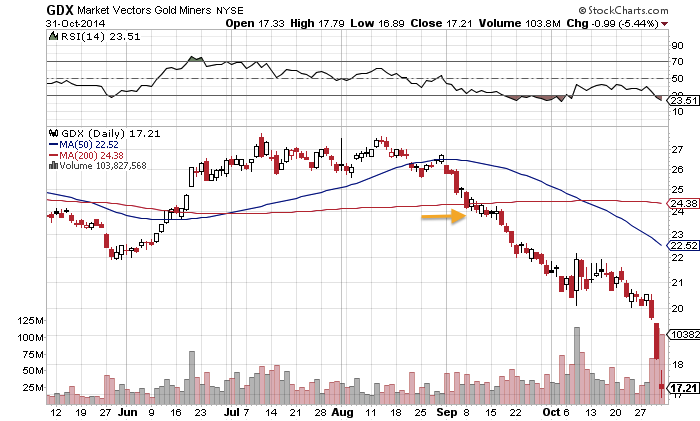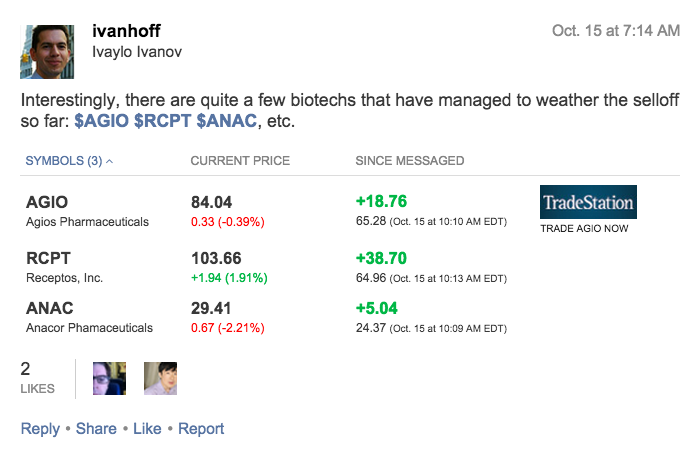When people study corrections, they usually focus on figuring out how they could have spotted the bottom and how they could have taken advantage of the recovery. A complete study of corrections requires giving the answer to the following three questions:
1. How to protect capital during corrections
2. How to take advantage of the correction and make money on the short side
3. How to make money during the recovery
How to protect capital during corrections
The answer will depend on your time frame. During corrections, correlations move towards 1.00, meaning that the majority of stocks decline, disregarding of their individual characteristics. As a swing and an occasional position trader, I prefer to raise my cash levels in order to minimize the drawdown in my accounts; therefore I am paying attention to hints that we might be entering a correction. One of the most practical market timing indicators is the behavior of momentum leaders. They usually lead on the way down and on the way up. This is why the SL50 list is not only a great equity selection tool, but also a very useful for market timing. It started to show relative weakness in early September and gave us plenty of hints to raise cash levels before things turned nasty in October.
How to take advantage of the correction and make money on the short side
The opportunity cost of shorting is not being long. The most you could make on a short position is a 100% and these are very rare events that take a long time to come to fruition. When you are long, sky is the limit, especially in a bull market. This is why it only makes sense to focus on short position when the general market is in downtrend.
I don’t believe in long-term shorting of stocks. Maybe, it is because I don’t have the skills, the knowledge and the stomach for the volatility. Maybe, because I am smart enough to figure out that long-term, the optimists prevail and stock prices go lower. For me, shorting is a short-term adventure, which is applied only once or twice a year when the indexes undergo correction.
All corrections feel the same. At the beginning, people don’t believe them, then as prices continue lower and weakness spread to more sectors, fear escalates and it leads to forced liquidation. Forced liquidation means selling, because you have to, not because you want to. Smart investors dream to be on the other side of forced liquidation. It is easier said than done. At the lowest point of a correction, the fear of losing is substantially higher than the fear of missing out.
It is said that stocks take the stairs up and the elevator down, therefore one could potentially make a lot of money quickly during market correction if you are positioned right. Don’t be afraid to add short exposure to your portfolio. At the beginning of a correction, no one knows that we are in one, but there are good risk to reward setups on the short side. We don’t know if they are going to work. What we know is that our odds of success are higher when all major indexes are trading below their declining 5dmas, which are below their declining 20dmas.
Here are a couple great short setups during the past correction. Both, Market Vectors Gold Miners (ARCA:GDX) and SPDR Energy Select Sector Fund (ARCA:XLE) were trading below their declining 50dma and bear-flagging near their 200dmas, before they had their fastest declines:

How to make money during the recovery
Two groups of stocks are the best performers when the market recovers from a deep correction: the ones that held the best (relative strength trades) and the once that dropped the most (mean-reversion trades)
Relative Strength Trades
Relative strength is a powerful equity selection tool, but it could be very misleading at the beginning stages of a correction. In a real correction, almost all stocks decline. Those that break out to new 52-week highs as the market averages start to deteriorate, often quickly reverse lower. From failed moves, come fast moves.
It has more value after the indexes decline for 8-10% or more. It is very simple to spot – stocks that go sideways while the indexes drop significantly. During corrections, correlations often go to 1.00. If a stock manages to hold its ground and consolidate through time or even make an attempt to make new high, it is likely being acquired by institutions. Because of the nature of their size, many institutions prefer to buy on pullbacks and during market corrections, because the provided liquidity masks their accumulation. Once the pressure from the general market is removed, those stocks tend to outperform. One of the sectors that managed to hold relatively well during the October correction was Biotech. Many people highlighted the relative strength in select biotech names:

Relative strength works beautifully, but not at the beginning of a correction. Pay more attention to it after 10% market pullback. Market corrections make people a lot of money. They just don’t know it at the time. After a 10% correction in the major indexes, most people are in capital protection mode or are willing to short the bounces. It is not an easy time to buy breakouts in stocks with relative strength, but you should do it – with a smaller position size, especially if the market averages show signs of bottoming.
Mean-Reversion trades
Human beings are wired to think in terms of mean-reversion and trying to fade the extremes. In bull markets, stocks could go a lot higher than anyone could comprehend or justify. During corrections, stocks could go a lot lower than most expect. Forget about levels of potential support. Bottoms are formed by strong buying, not buy strong selling. Look for wide-range, huge volume reversal candles that close above their opening level. Also, context is really important – Big prolonged market correction, happen when the indexes have their 50-week moving averages below their 200-week moving averages. I talked about it on October 15.
Pay attention to sentiment. If you see people becoming bold enough to write about the possibility of a 1929 or 1987 crash or that the market has 10% more downside after being down 10%, the odds are that we are closer to a bottom.
Buying oversold indexes and liquid stocks looks easy only in hindsight. It is not for everyone and it often requires averaging down. Everyone has heard of “Losers average down losers” saying which is attributed to Paul Tudor Jones – he probably knows that from experience. The truth is that there are traders who have a clear strategy how to average down in oversold ETFs and make money consistently doing exactly that. To buy an oversold index, means to assume that you are not going to be right immediately and that its prices might go much lower.
If you open with too big of a position too soon, you might
1) get liquidated as price continues to drop.
2) get so tired of holding a losing position for awhile that you are going go sell it for break-even when the bounce come and miss on bigger games when the expected bounce actually comes.
Keep in mind that not all corrections end up with a V-shaped recovery. Many of them go into long wide-range, highly volatile phase that could shake the confidence out of even the most experienced.
Many traders’ favorite new way to play a market bounce is via in the inverse volatility ETFs like VelocityShares Daily Inverse VIX (NASDAQ:XIV) and ProShares Short VIX Short-Term Futures (ARCA:SVXY).
Volatility tends to mean-revert, but it could remain elevated and spike to levels no one can comprehend. Shorting volatility when the VIX gets above 20 has been a really profitable approach in the past couple of years; therefore the consensus thinking is to short volatility when the VIX goes above 20. Guess what? In October, VIX briefly tagged 30, before it reversed. If you shorted volatility with a sizable position when VIX reached 20, you were probably stopped out. During the last sizable correction in 2011, the VIX remained above 30 for almost 3 months. Wait for some confirmation in terms of candle reversal pattern in the indexes, before you go with size.

If you are going to take mean-reversion trades, use a variety of liquid indexes – like Direxion Daily Small Cap Bull 3X Shares (ARCA:TNA) and ProShares Trust UltraPro QQQ (NASDAQ:TQQQ) for example. Don’t rely only on inverse volatility indexes like VelocityShares Daily Inverse VIX (NASDAQ:XIV) and ProShares Short VIX Short-Term Futures (ARCA:SVXY). If a correction turns into a prolonged bear market, volatility will remain elevated for a very long time and those indexes could have 90% drawdowns. Volatility could remain high longer than you could remain solvent, if your position sizing is too big. I talked about it on Oct 16 here.
Disclosure: The information in this blog post represents my own opinions and does not contain a recommendation for any particular security or investment. I or my affiliates may hold positions or other interests in securities mentioned in the Blog, please see my Disclaimer page for my full disclaimer.
